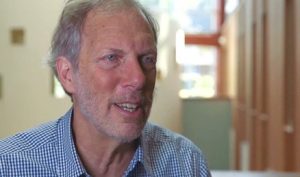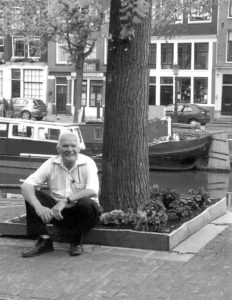
Prof.dr. Robert Pollin
In the debate about what strategy to adopt to combat climate change, the Green New Deal has quickly become the new buzzword on the left. Is it an insufficient social-democratic response to the present crisis, or is it, in fact, the only realistic project we have to save the planet? Robert Pollin, distinguished professor of economics and co-director of the Political Economy Research Institute at the University of Massachusetts at Amherst, is a leading proponent of a green future and he shared his vision of the Green New Deal in the interview below, which appeared originally in Swedish in the left paper Flamman.
Jonas Elvander: You are one of the most well-known scientific spokespersons for a so-called “Green New Deal.” Can you explain what that means?
Robert Pollin: In my view, the core features of the Green New Deal are quite simple. They consist of a worldwide program to invest between 2-3 percent of global GDP every year to dramatically raise energy efficiency standards and equally dramatically expand lean renewable energy supplies.
Here is why this is the core of the Green New Deal. Last October 2018, the Intergovernmental Panel on Climate Change (IPCC) issued a new report emphasizing the imperative of limiting the rise in the global mean temperature as of 2100 by 1.50C [1.5 degrees Celsius] only, as opposed to 2.00C. The IPCC now concludes that limiting the global mean temperature increase to 1.50C will require global net CO2 [carbon dioxide] emissions to fall by about 45 percent as of 2030 and reach net zero emissions by 2050. These new figures from the IPCC provide a clear and urgent framework for considering alternative approaches for fighting climate change.
To make real progress on climate stabilization, the single most critical project at hand is straightforward: to cut the consumption of oil, coal and natural gas dramatically and without delay, and to eliminate the use of fossil fuels altogether by 2050. The reason this is the single most critical issue at hand is because producing and consuming energy from fossil fuels is responsible for generating about 70 percent of the greenhouse gas emissions that are causing climate change. Carbon dioxide (CO2) emissions from burning coal, oil and natural gas alone produce about 66 percent of all greenhouse gas emissions, while another 2 percent is caused mainly by methane leakages during extraction.
At the same time, people do still need and want to consume energy to light, heat and cool buildings; to power cars, buses, trains and airplanes; and to operate computers and industrial machinery, among other uses. It is pointless to pretend this isn’t so — that is, to insist that everyone embraces permanent austerity. As such, to make progress toward climate stabilization requires a viable alternative to the existing fossil-fuel dominant infrastructure for meeting the world’s energy needs. Energy consumption and economic activity more generally therefore need to be absolutely decoupled from the consumption of fossil fuels. That is, the consumption of fossil fuels will need to fall steadily and dramatically in absolute terms, hitting net zero consumption by 2050, even while people will still be able to consume energy resources to meet their various demands.
Energy efficiency entails using less energy to achieve the same, or even higher, levels of energy services from the adoption of improved technologies and practices. Examples include insulating buildings much more effectively to stabilize indoor temperatures; driving more fuel-efficient cars or, better yet, relying increasingly on well-functioning public transportation systems; and reducing the amount of energy that is wasted both through generating and transmitting electricity and through operating industrial machinery. Expanding energy efficiency investments support rising living standards because raising energy efficiency standards, by definition, saves money for energy consumers. Raising energy efficiency levels will generate “rebound effects” — i.e. energy consumption increases resulting from lower energy costs. But such rebound effects are likely to be modest within the current context of a global project focused on reducing CO2 emissions and stabilizing the climate.
As for renewable energy, the International Renewable Energy Agency (IRENA) estimated in 2018 that, in all regions of the world, average costs of generating electricity … are now roughly at parity with fossil fuels. This is without even factoring in the environmental costs of burning oil, coal and natural gas. Solar energy costs remain somewhat higher on average. But, according to IRENA, as a global average, solar photovoltaic costs have fallen by over 70 percent between 2010 and 2017. Average solar photovoltaic costs are likely to also fall to parity with fossil fuels as an electricity source within five years.
Through investing about 3 percent of global GDP per year in energy efficiency and clean renewable energy sources, it becomes realistic to drive down global CO2 emissions by roughly 50 percent relative to today within 10 years while also supporting rising living standards and expanding job opportunities. CO2 emissions could be eliminated altogether in 30 years through continuing this clean energy investment project at even a somewhat more modest rate of about 2 percent of global GDP per year. It is critical to recognize that, within this framework, a more rapid economic growth rate will also accelerate the rate at which clean energy supplants fossil fuels, since higher levels of GDP will correspondingly mean a large total amount of investment funds are channeled into clean energy projects.
For 2018, global clean energy investments levels were at about $330 billion, 0.4 percent of global GDP. Thus, the increase in clean energy investments will need to be in the range of 2.5 percent of global GDP through 2030 — that is, about $2 trillion at the current global GDP level of about $80 trillion, then rising in step with global GDP growth thereafter — to achieve a 50 percent emissions reduction within 10 years. The consumption of oil, coal and natural gas will also need to fall steadily to zero over this 30-year period. This requires an absolute decline of about 3.5 percent per year, with larger cuts through 2030 and somewhat smaller ones from 2031-2050.
For this global clean energy investment project to be successful will obviously require very aggressive policies. They will include unbending regulatory commitments to forcing big cuts in fossil fuel consumption and production every year until fossil fuel consumption is driven to net zero by 2050, large-scale public investments to build clean energy infrastructures, as well as public subsidies that will support clean energy investments by private businesses. Rich countries will also have to subsidize clean energy investments in low-income countries. The rich countries have created the problem in the first place by having burned fossil fuels for nearly two centuries to undergird capitalist development. On minimal grounds of fairness, they now need to pay for the cleanup.
When private capitalists receive public subsidies for clean energy investments, they will have to accept limits on their profit opportunities in exchange, in the way that is done now with privately owned electrical utilities in the U.S. and elsewhere. This in turn raises the issue of ownership of newly created energy enterprises and assets. Specifically, how might alternative ownership forms — including public ownership, community ownership, and small-scale private companies — play a major role in advancing the clean energy investment agenda? Throughout the world, the energy sector has long operated under a variety of ownership structures, including public/municipal ownership, and various forms of private cooperative ownership in addition to private corporations. Indeed, in the oil and natural gas industry, publicly owned national companies control approximately 90 percent of the world’s reserves and 75 percent of production. They also control many of the oil and gas infrastructure systems. These national corporations include Saudi Aramco, Gazprom in Russia, China National Petroleum Corporation, the National Iranian Oil Company, Petróleos de Venezuela, Petrobras in Brazil, and Petronas in Malaysia. But there is no evidence to suggest that these publicly owned fossil fuel-based energy companies are likely to be more supportive of a clean energy transition than are the private energy corporations. National development projects, lucrative careers and political power all depend on continuing the flow of large fossil fuel revenues. In and of itself, public ownership is not a solution.
Clean energy investments will nevertheless create major new opportunities for alternative ownership forms, including various combinations of smaller-scale public, private and cooperative ownership. For example, in your region of the world, community-based wind farms have been highly successful for roughly nearly two decades. A major reason for their success is that they operate with lower profit requirements than big private corporations.
There is a widely held belief that advancing a viable climate stabilization project is necessarily in conflict with another fundamental set of goals of the left, which is to raise mass living standards, eliminate poverty and expand job opportunities. This position is wrong. The investments aimed at dramatically raising energy efficiency standards and expanding the supply of clean renewable energy will generate tens of millions of new jobs in all regions of the world. This is because, in general, building a green economy entails more labor-intensive activities than maintaining the world’s current fossil fuel-based energy infrastructure. Average incomes can therefore rise as clean energy supplants our existing dominant fossil fuel energy infrastructure. At the same time, unavoidably, workers and communities whose livelihoods depend on the fossil fuel industry will lose out in the clean energy transition. Unless strong policies are advanced to support these workers, they will face layoffs, falling incomes and declining public-sector budgets to support schools, health clinics and public safety. It follows that the global Green New Deal must commit to providing generous transitional support for workers and communities tied to the fossil fuel industry.
For many the name brings to mind FDR’s New Deal. Is that a valid comparison?
I think it is an evocative and generally useful comparison. The New Deal was, to a significant extent, a project to advance equality and social justice within U.S. capitalism while also confronting the severe crisis of the 1930s Great Depression. The 1930s New Deal happened because the labor movement and left in the U.S. fought for it, and Roosevelt was willing to be pushed. There were also specific green features of the 1930s New Deal project, in particular, the Civilian Conservation Corps, which provided jobs for unemployed workers in the areas, such as erosion and flood control, forest protection, and creating public parks and other recreation areas. At the same time, as Ira Katznelson has documented powerfully in his 2013 book, Fear Itself, FDR compromised with Southern racist politicians in enacting the New Deal, thus upholding the virulent institutionalized racism of that era. So obviously, the Green New Deal must totally reject that feature of the FDR legacy. Even more, the Green New Deal should create opportunities to advance racial and gender equality in employment, especially given that a high percentage of the new jobs generated by clean energy investments will be in construction and manufacturing. Focusing for the moment on the U.S., these are sectors of the U.S. labor market that continue to be dominated by white males.
In your recent essay in the New Left Review you criticize those eco-socialists who are skeptical of economic growth for being naive or vague. Is not economic growth incompatible with a sustainable environment?
The term “economic growth” is too general to be useful here. Under the Green New Deal project that I am proposing, in fact, it is absolutely imperative that some categories of economic activity must grow massively— those associated with the production and distribution of clean energy. Concurrently, the global fossil fuel industry needs to contract massively — i.e. to ‘de-grow’ steadily and dramatically until it has completely shut down within the next 30 years. In my view, addressing these matters in terms of their specifics is much more constructive in addressing climate change than presenting broad generalities about the nature of economic growth, positive or negative.
What are your main objections to proponents of degrowth?
Let me emphasize here that I share virtually all the values and concerns of degrowth advocates. I agree that uncontrolled economic growth produces serious environmental damage along with increases in the supply of goods and services that households, businesses and governments consume. I also agree that a significant share of what is produced and consumed in the current global capitalist economy is wasteful, especially most of what high-income people throughout the world consume. It is also obvious that growth per se as an economic category makes no reference to the distribution of the costs and benefits of an expanding economy.
Nevertheless, on the specific issue of climate change, degrowth does not provide anything resembling a viable stabilization framework. Consider some very simple arithmetic. Following the IPCC, we know that global CO2 emissions need to fall by roughly 50 percent within 10 years and need to be eliminated altogether within 30 years. Now assume that, following a degrowth agenda, global GDP contracts by 10 percent over the next decade. That would entail a reduction of global GDP four times larger than what we experienced over the 2007–09 financial crisis and Great Recession. In terms of CO2 emissions, the net effect of this 10 percent GDP contraction, considered on its own, would be to push emissions down by precisely 10 percent. The global economy would still not come close to bringing emissions down to by 50 percent by 2030.
Clearly then, even under a degrowth scenario, the overwhelming factor pushing emissions down will not be a contraction of overall GDP butmassive growth in energy efficiency and clean renewable energy investments (which, for accounting purposes, will contribute toward increasing GDP) along with similarly dramatic cuts in fossil fuel production and consumption (which will register as reducing GDP). Moreover, any global GDP contraction would result in huge job losses and declines in living standards for working people and the poor. Global unemployment rose by over 30 million during the Great Recession. I have not seen any degrowth advocate present a convincing argument as to how we could avoid a severe rise in mass unemployment if GDP were to fall twice as much as during 2007-09.
These fundamental problems with degrowth are well illustrated by the case of Japan, which has been a slow-growing economy for a generation now, even while maintaining its average per capita income at a high level. To be specific, between 1996-2015, GDP growth in Japan averaged an anemic 0.7 percent per year. This compares with an average growth rate of 4.8 percent per year for the 30-year period 1966-1995. Nevertheless, Japan remained in the upper income ranks among large economies, with average GDP per capita at about $40,000.
Despite the fact that Japan has been close to a no-growth economy for 20 years, its CO2 emissions remain among the highest in the world, at 9.5 tons per capita. This figure is 40 percent below that for the United States. But it is also five times higher than the average global figure of 2 tons per capita that must be achieved for global emissions to fall by 50 percent as of 2030. Moreover, Japan’s per capita emissions have not fallen at all since the mid-1990s. The reason is straightforward: as of 2015, 92 percent of Japan’s total energy consumption comes from burning oil, coal and natural gas.
Thus, despite having become close to a no-growth economy, Japan has accomplished virtually nothing in advancing a viable climate stabilization path. The only way it will make progress is to replace its existing fossil-fuel dominant energy infrastructure with a clean-energy infrastructure. At present, hydropower supplies 5 percent of Japan’s total energy needs and all other renewable sources supply only 3 percent. Overall then, like all large economies — whether they are growing rapidly or not at all — Japan needs to embrace the Green New Deal.
Your proposal does not only not question growth as such, but it also does not question the capitalist version of growth. Do you therefore think it is fair to characterize the GND as a social-democratic or Keynesian alternative to Marxist or other anti-capitalist climate strategies? Or are these distinctions irrelevant?
I don’t agree with your characterization of my position. As I said above, I certainly do not advocate economic growth for its own sake. Rather, the Green New Deal offers the only approach to climate stabilization that can deliver an expansion of good job opportunities and rising mass living standards. In all the literature on de-growth, I have not seen a single credible presentation as to how you expand job opportunities and raise mass living standards under a de-growth scenario. The Green New Deal is therefore the only viable climate stabilization framework that can also reverse the rise in inequality and defeat both global neoliberalism and ascendant neo-fascism.
And right, I really don’t know what exactly one means by a “Marxist” or “anti-capitalist” climate stabilization approach, as distinct from a Green New Deal. I say this sincerely. These terms are far too vague. Do we mean the overthrow of all private ownership of productive assets, and the takeover of them by public ownership? Does anybody seriously think this could happen within the timeframe we have to stabilize the climate, i.e. within no more than 30 years? And are we certain that eliminating all private ownership will be workable or desirable from a social justice standpoint — i.e. from the standpoint of advancing well-being for the global working class and poor? How do we deal with the fact that most of the world’s energy assets are already publicly owned? How, more specifically, can we be certain that a transition to complete public ownership will itself deliver zero net emissions by 2050? To me, the overarching challenge as a leftist economist is to try to understand the alternative pathways to most effectively build truly egalitarian, democratic and ecologically sustainable societies, putting all labels aside, and being willing, as Marx himself insisted, to “ruthlessly criticize” all that exists, including all past experiences with Communism/Socialism, and, for that matter, all authors, including Marx himself. Indeed, my favorite quote from Marx is “I am not a Marxist.”
What would be the effects of the GND on such phenomena as inequality and exploitation?
As noted above, the whole idea behind the Green New Deal is to advance a climate stabilization program that also expands good job opportunities and raises mass living standards on a global scale. My own research and policy work with co-authors has applied this approach globally, including to low-income countries, such as India and Indonesia, and to countries living under austerity conditions, such as Spain five years ago and Puerto Rico today. Overall, the Green New Deal is precisely a project to reverse the rise of inequality under neoliberalism while also preventing ecological catastrophe. One could call it broadly social-democratic in its approach, as was the original 1930s New Deal. But again, I think it is most helpful to get beyond labels and commit to something very specific — that is, to advancing the most fair and workable program possible to achieve climate stabilization in the very short amount of time that remains to accomplish this.
Even if the GND is the most realistic project to deal with climate change, do you think the short-sighted democratic systems in the West will allow for a program with such ambitions and far-reaching consequences to pass?
This is, of course, an open question. At the same time, the answer absolutely must be “yes” for us, for we, the citizens of planet earth, to stop courting ecological disaster through climate change. The fact that the Green New Deal is fully compatible with expanding job opportunities and raising mass living standards — in other words, that it will not require people sacrificing their current standard of living or prospects for improving their living standard — should be critical to its success.
Some significant positive developments have emerged recently both in Europe and the U.S. For example, on June 20, at the EU Summit in Brussels, 25 EU states supported the net zero emissions target by 2050. The measure was defeated by the right-wing governments of Poland, Hungary and the Czech Republic. But it was still an important positive step. At the country level within Europe, the U.K. endorsed the 2050 emissions reduction target on June 27. Other countries are moving quickly in the same direction. Within the U.S., New York State just passed a serious policy program for reaching net zero within the state by 2050. Some other states are moving in the same direction, including California, Oregon and Colorado. Of course, all such programs need to be carried out in practice, not just supported on paper then forgotten when political resistance emerges. The support for such measures also, obviously, needs to spread to all regions and countries, with China and the U.S. being two of the three centerpieces, along with Europe.
There is no denying that we face daunting challenges. For starters, we are up against the massively powerful vested interests of the global fossil fuel industry. The fossil fuel industry will never have any problem finding politicians like Trump to do their bidding. In the face of such realities, I find it useful to regularly recall the great dictum by Antonio Gramsci, “Pessimism of the mind; optimism of the will.”
Note: A Swedish language version of this interview previously appeared in the Swedish left paper Flamman.
Jonas Elvander is a foreign editor at
Flamman, a left Swedish newspaper




